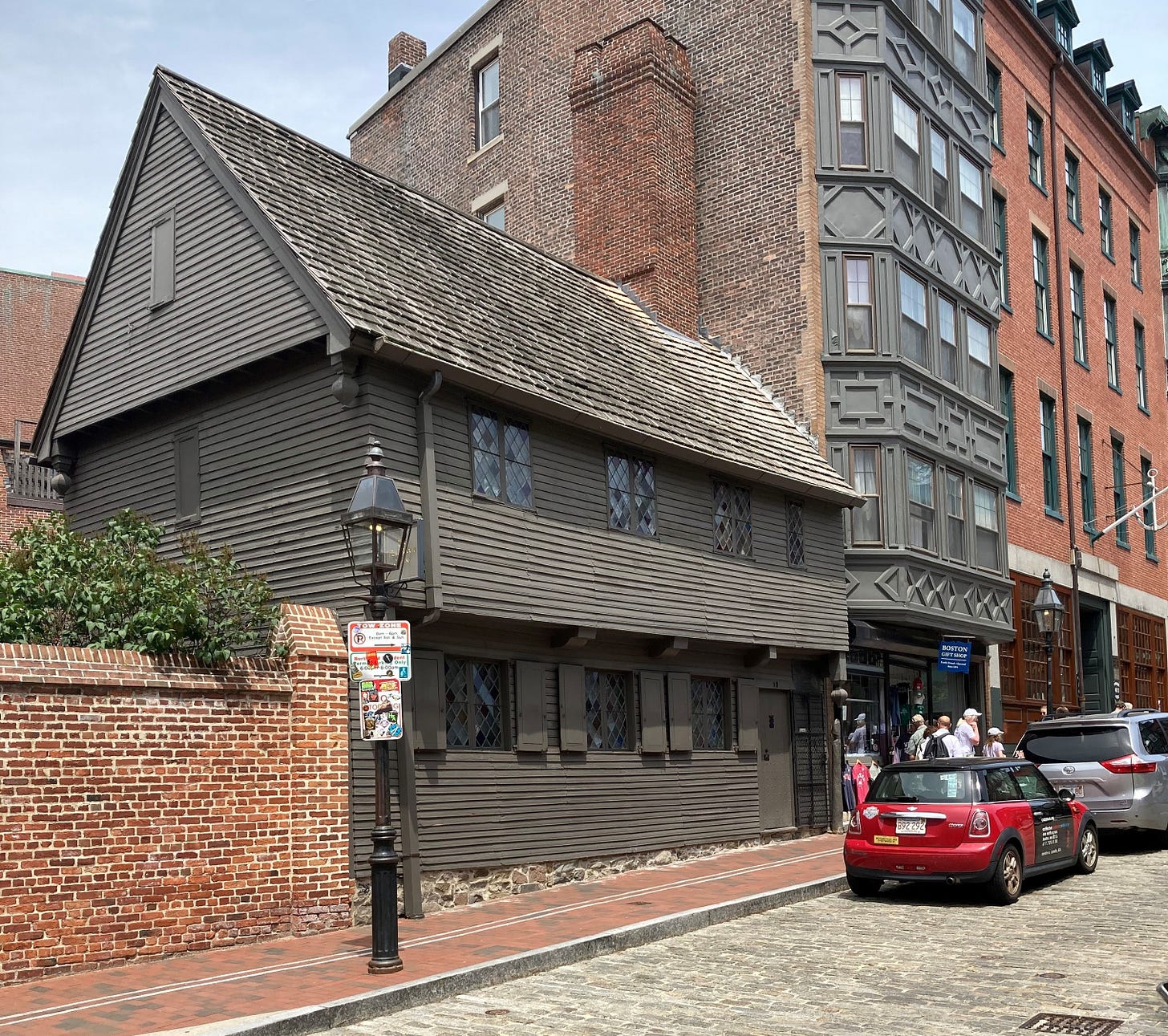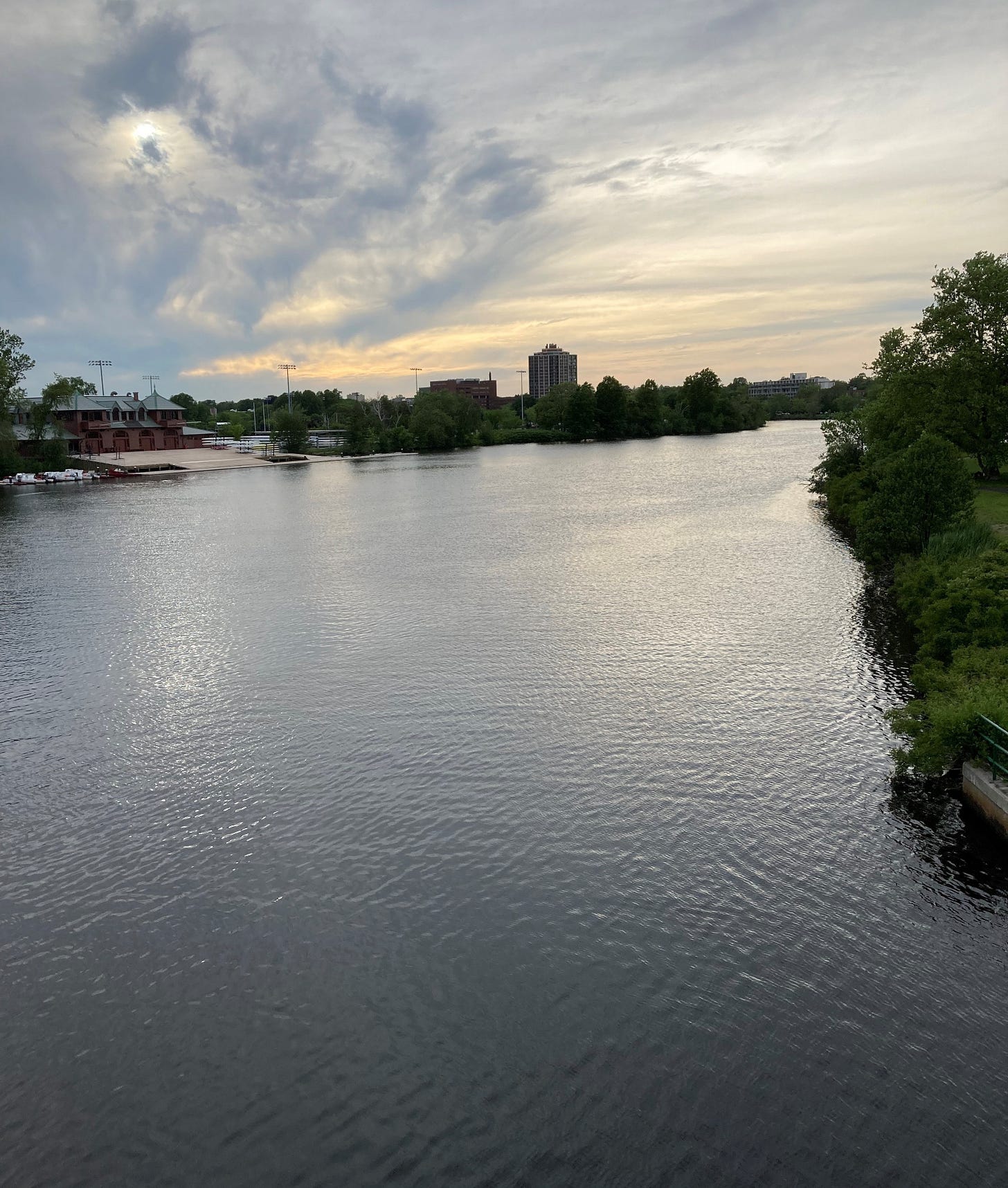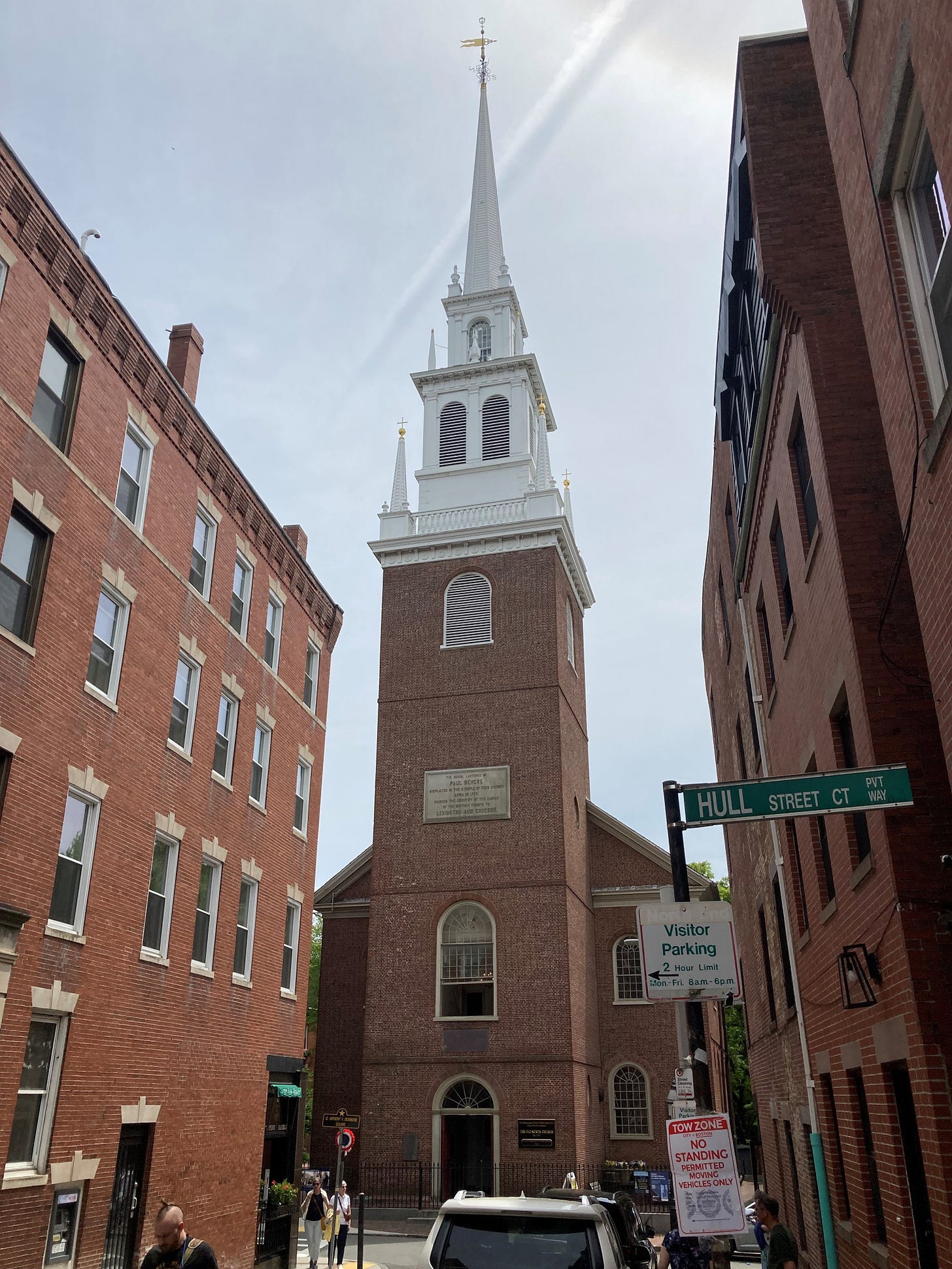
What was supposed to be my 100th post became #101…. What was supposed to be a July 4th post becomes, today, a July 12th post! Better late than never, right?
Listen, my children, and you shall hear
Of the midnight ride of Paul Revere,
On the eighteenth of April, in Seventy-Five;
Hardly a man is now alive
Who remembers that famous day and year.
(Henry Wadsworth Longfellow,
"Paul Revere's Ride" (1860)In late May, we traveled to Boston for our son’s law school graduation. While there, we had a morning free while he was occupied and before any of the ceremonies got started. So we looked for a useful way to fill that time in the city. It needed to be something we could take in reasonably quickly, seeing what was there to be seen in our limited time, and not too expensive.
My wife—who, I should say, is very good at this sort of thing—found a perfect solution: the Paul Revere House. It’s a little hard to believe, but his home is still standing—the oldest house still standing in downtown Boston, in fact. It is open to the public for tours and even contains some of his own furniture, which has been passed down through the family across generations. So you can see the very chair he sat in and can stand inside his own four walls. As Kostya Kennedy puts it in The Ride: Paul Revere and the Night That Saved America, published earlier this year in honor of the 250th anniversary of Revere’s famous ride: “Inside and out [the house] looks essentially as it looked 250 years ago, on the night when Paul Revere stood within its wall, donned his overcoat, pulled on his boots, and headed out toward the Charles River and then to a horse on the opposite shore.”
Every American schoolchild hears about Paul Revere’s ride at some point. But as I read the information in his house, I was struck by the extent of his civic activity. Revere may be especially remembered for that one ride on the night of April 18, 1775, but he played many roles and was near the center of revolutionary activity in Boston, as Kennedy’s book makes abundantly clear. As an engraver and silversmith who also taught himself to make dentures, Revere knew many people and was well liked. He was active in the Committee of Correspondence, helping coordinate activities and share information throughout the revolutionary network. He took part in the Boston Tea Party and was a skilled express rider who had delivered other important messages for the revolutionary leadership before the fateful night of April 18. He belonged to the Freemasons, becoming a grand master and being elected to lead the Massachusetts Grand Masonic Lodge for five years running. Kennedy portrays Revere as a man of action—the right man in the right place when the critical moment arrived “on the eighteenth of April, in Seventy-Five.”
One, if by land, and two, if by sea;
And I on the opposite shore will be,
Ready to ride and spread the alarm
Through every Middlesex village and farm,
For the country-folk to be up and to arm.But of course however active he may have been, however well respected and widely networked, we remember Paul Revere because of his famous ride. Many of us have probably learned of that ride, as did I, primarily through Longfellow’s great poem—which does however (as Longfellow knew), take some liberties with the night’s events, though Kennedy suggests that it is true to the spirit of what happened.
When revolutionary leadership got word—perhaps leaked by the American wife of British General Thomas Gage—that the British army was planning to march on the city of Concord in order to remove military supplies stored there, they sent for a pair of express riders, Revere and a man named William Dawes. Both of them, taking slightly different routes, were to slip out of Boston under cover of darkness, racing to the towns of Lexington and Concord just ahead of the British soldiers and warning the citizenry to prepare. Dawes is less remembered today; Kennedy argues that Revere’s greater fame is justified, because he appears to have been more successful at rousing the countryside to action. (Revere himself always acknowledged Dawes’s shared role in their mission.)
What followed was worthy of a spy thriller. Knowing that he might fail to escape detection, Revere arranged for a pair of lanterns to be hung in the steeple of the Old North Church as a signal that the British were leaving Boston “by sea,” crossing the Charles River. A pair of associates then rowed him across the river in a boat—within sight of the Somerset, a giant British warship. He borrowed a horse and set off, while Dawes took a more southerly route. Revere encountered a British patrol and was pursued but barely escaped capture. He safely reached Lexington, where he warned John Hancock and Samuel Adams of the British approach. He was met there by Dawes, and the two of them continued on toward Concord.
Along the way they were joined by a doctor, Samuel Prescott, who offered to help them spread the word. Again they ran into British soldiers. Revere and Dawes were captured, while Prescott escaped and successfully continued on to Concord. Revere was fortunate to come away with his life when the Redcoats, spooked by the sound of continental fire, released him. By that point, however, his work had been done; those he had roused, carrying his message further, gathered the rebel army that met the British at Concord, peppered them on their retreat to Lexington, and drove them in defeat back to Boston. As Revere later wrote in an account of that evening, “I alarmed almost every House, till I got to Lexington.” The American Revolution had begun.
A hurry of hoofs in a village street,
A shape in the moonlight, a bulk in the dark,
And beneath, from the pebbles, in passing, a spark
Struck out by a steed flying fearless and fleet:
That was all! And yet, through the gloom and the light,
The fate of a nation was riding that night;
And the spark struck out by that steed, in his flight,
Kindled the land into flame with its heat.One thing Kennedy does very well in The Ride is set the scene for all this. I’ve never thought very much about what it would have felt like to be in the city of Boston in the days and weeks before Revere’s ride. But Kennedy vividly describes how tense the situation was. Everyone, British and American alike, was on edge.
Boston was in many respects an occupied city. British soldiers were present everywhere, quartered in American homes and patrolling the streets and countryside. The British and the “Patriots” both had their networks of spies and informants. British taxation provoked colonial resistance which in turn provoked greater British severity in a kind of vicious cycle, ratcheting tensions ever higher as American grievances hardened and George III became increasingly determined to break the rebels’ spirit.
Revere himself was well known to the British for his revolutionary sympathies and his activity on behalf of the resistance. He was a marked man. But he was only one of many people who ran great risks for the American cause. Resistance to British authority, after all, was treason. It’s a genuinely exciting story, and Kennedy makes it come alive, helping us feel the American resentment and anger. He reminds us also that Revere’s ride, in which he “rose to the moment, putting an ideal, and a people, ahead of himself,” is “proof that a single conscious act can change the world, and one’s place within it.”

An exciting story, but one about which I have mixed feelings. Not about Revere himself, who was a pretty impressive and admirable figure. But about his broader cause. For it’s by no means clear to me that the American Revolution was justified. Two of the thinkers who have most influenced my views on such matters are Luther and Burke. Both set the bar for resistance to government authority quite high. Revolutions are almost always destructive. Institutions are destroyed, bonds of community torn asunder, property plundered. People are killed. As Burke wrote, “To make a revolution is a measure which, prima fronte, requires an apology. To make a revolution is to subvert the ancient state of our country; and no common reasons are called for to justify so violent a proceeding.”
The American colonists, of course, had their “apology,” what they regarded as uncommon reasons. In the Declaration of Independence, they explicitly denied that they were rebelling for “light and transient causes”; they were responding, rather, to “a long train of abuses and usurpations,” aiming to “reduce them under absolute Despotism.” It is somewhat difficult to regard the British government of the time as an “absolute Despotism.” The famous shorthand for the colonists’ chief grievance was “no taxation without representation.” But many of those taxes were being levied so that the crown could recoup the costs of protecting the colonies, whether in the French and Indian War or against Native American incursions across the long and hard to defend frontier. It was true, of course, that the colonists did not send elected representatives to Parliament; the British argued that they were “vitually” represented in Parliament, but here the colonists surely had a legitimate complaint. Still, one does not launch a revolution over a theory of representation.
To be honest, though, I have more or less, 250 years after the Revolution, simply made my peace with being happily hypocritical about the whole thing. Revere, Hancock, Adams, and Co. may have been justified, or they may not… but I’m glad they succeeded. Perhaps I am illicitly enjoying the fruits of their wrongdoing. But I’m happy there’s a United States, happy to be among its citizens, happy to be here. I wouldn’t recommend handing the country back over to Charles III. I’m actually a pretty patriotic fellow. I even get choked up when I read Longfellow’s poem.
For, borne on the night-wind of the Past,
Through all our history, to the last,
In the hour of darkness and peril and need,
The people will waken and listen to hear
The hurrying hoof-beat of that steed,
And the midnight passage of Paul Revere.Kennedy includes a short chapter about that poem. Henry Wadsworth Longfellow wrote “Paul Revere’s Ride” in 1860. That was of course a fraught year in American history; on November 6, Abraham Lincoln would be elected president amid rising tensions over slavery. In April of that year, Longfellow began writing the poem, inspired by a climb up the steeple of the Old North Church, where Revere had instructed that the signal lanterns be hung. Longfellow was an abolitionist and a good friend of the outspoken abolitionist leader Charles Sumner. “Paul Revere’s Ride” appeared in The Atlantic Magazine on December 20, 1860, just a few weeks after Lincoln’s election. That same day South Carolina became the first state to secede from the Union.
Revere’s ride surely had a deeper significance for Longfellow, therefore. His “cry of defiance and not of fear,” his “word that shall echo forevermore,” was a warning not only to the citizens of Lexington and Concord, but also to future Americans almost a century later. In their “hour of darkness and peril and need,” Longfellow appealed to them: they should “waken and listen to hear… the midnight passage of Paul Revere.” When we read his poem now, Longfellow still makes the same appeal to us.
Which brings me full circle, back to where I began: the Paul Revere House. If you find yourself in Boston, you should pay it a visit, remembering Revere and his midnight ride. As I neared the end of Kennedy’s book, I enjoyed the pleasant little jolt of recognition that came with hearing him describe the very house I’d stood inside just a few weeks earlier. I quoted part of the passage earlier, but let me close by returning to it here:
The Paul Revere House draws more than 250,000 visitors a year from all over the country and the world. On significant years, and 2025 is one, it might draw close to 325,000. Each year the USS Constitution brings graduates of its chief petty officers’ training program to Paul Revere House, where they gather in the courtyard and sing “Anchors Aweigh.” The house stands as the oldest remaining residence anywhere in downtown Boston. Inside and out it looks essentially as it looked 250 years ago, on the night when Paul Revere stood within its walls, donned his overcoat, pulled on his boots, and headed out toward the Charles River and then to a horse on the opposite shore.
As always, thanks for reading, and I’ll see you next time for another installment “From My Bookshelf.”





Very interesting background on Revere’s Ride. I have always loved the poem. My grandmother used to tell it like a ghost story when I was younger. She loved Longfellow. One year I taught fifth graders , and the entire class memorized this poem. They loved it too.
Thank you for a thoughtful and timely ride into American history and literature!